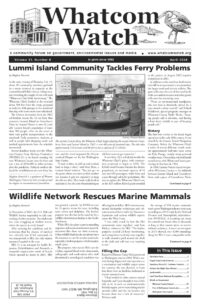Editor’s Note: This is the eighth in a multipart series on the health of northern Puget Sound and Georgia Strait. It was first published in October 2002 by RE Sources and the North Sound Baykeeper under the title, “State of the North Sound and Straits.”
by Lauren Mulroy and Robyn du Pré
Many laws regulate different aspects of the marine environment. From fishing to dredging to tanker traffic, laws abound. Because of space limitations, we will not attempt to present a comprehensive list of all laws affecting the marine ecosystem, but will name a few of the most influential:
Clean Water Act/Federal Water Pollution Control Act
The Clean Water Act/Federal Water Pollution Control Act regulates the discharge of pollutants into the nation’s navigable waters. The Clean Water Act (CWA) is administered by the Environmental Protection Agency (EPA). In 38 states, the EPA has delegated this authority to the state. Here in Washington, the state Department of Ecology (DOE) is responsible for CWA implementation.
Coastal Zone Management Act/State Shoreline Management Act
These laws regulate development in coastal areas. The National Oceanic and Atmospheric Administration administers the Coastal Zone Management Act (CZMA), with the states reviewing various actions for consistency with CZMA. The Shoreline Management Act is administered by the state DOE.
Superfund/State Model Toxics Control Act
The Comprehensive Environmental Response, Compensation, and Liability Act (commonly known as Superfund) and state Model Toxics Control Act (MTCA) regulate the cleanup of contaminated sites and detail the process through which the government may seek redress from liable parties. Superfund is administered by the Environmental Protection Agency and MTCA is administered by the state DOE.
Endangered Species Act
The act provides a framework for assessing the status of a particular species and listing it as threatened or endangered. Once a listing has occurred, management is prescribed by the responsible agency. For marine organisms, the National Marine Fisheries Service is responsible for implementation.
Marine Mammal Protection Act
This act was passed in 1978 to address the serious decline in marine mammal populations. All marine mammals enjoy protected status that makes harassing, injuring or killing them a crime. The National Marine Fisheries Service administers this law.
Ocean Dumping Act
The Ocean Dumping Act (ODA) regulates the intentional ocean disposal of materials. It also authorizes research, the establishment of marine sanctuaries, and coastal water quality monitoring. Four federal agencies have authority under the ODA: the EPA, the U.S. Army Corps of Engineers, the National Oceanic and Atmospheric Administration and the Coast Guard.
Oil Pollution Prevention Act of 1990 (OPPA)
This act makes parties responsible for the discharge of oil into the water liable for the costs of cleanup. The Coast Guard has primary responsibility under the OPPA.
A Primer on the Clean Water Act
The year 2002 marked the 30th anniversary of the Clean Water Act, making that year the “Year of Clean Water.” This is a landmark law for several reasons: it acknowledged, for the first time, that we all have a right to clean water, and it gave citizens the power to enforce the law if the government agencies entrusted with this responsibility don’t.
When Congress passed the Clean Water Act in October of 1972, our nation’s waterways were in crisis. Many rivers, bays and sounds were so polluted that fish kills and beach closures were an ordinary occurrence. Lake Erie was declared dead, the Cuyahoga River was on fire, and our own Bellingham Bay made National Geographic magazine because of mercury-laden sediments (October 1972). The Clean Water Act was viewed as an important way to rein in unlimited discharges of pollution into our nation’s waterways and to give citizens power to steward the waters of our homes.
The goals of the Clean Water Act were clearly stated:
• “to restore and maintain the chemical, physical and biological integrity of the Nation’s waters” — that is, to make all waters “fishable, drinkable, swimmable.”
• “To eliminate the discharge of pollutants into navigable waters by 1985.”
Many Changes Since 1972
A lot has changed in the last 30 years. We now have an Environmental Protection Agency and an institutionalized environmental regulatory regime. The Cuyahoga River is no longer in flames, and people are fishing in Lake Erie again. But, mercury discharges to Bellingham Bay ceased only two and a half years ago — leaving a legacy of contamination still to be dealt with. All of the commercial shellfish beds in Whatcom County are closed to harvest due to fecal contamination, and 76 rivers, lakes and bays in Whatcom and Skagit Counties alone fail to meet water quality standards.
Clearly, we have not restored the integrity of our waters, nor have we eliminated the discharge of pollutants. Part of the reason for this is that the regulatory agencies have been captured by the very interests they are supposed to regulate. It has been relatively easy for this to happen, because citizen pressure just isn’t there to encourage regulators to rigorously enforce the law. The Clean Water Act was designed to give citizens tools to work for their local waterways, but few people understand the act or how to effectively engage in advocacy using this powerful tool.
______________________
At the time this series was written, Lauren Mulroy was an RE Sources intern. Robyn du Pré had been the North Sound Baykeeper and had coordinated RE Sources water programs for eight years. She was teaching field-based environmental studies for the Audubon Expedition Institute.




























